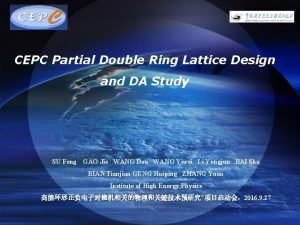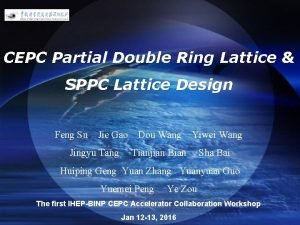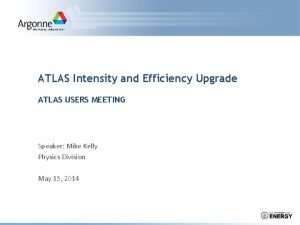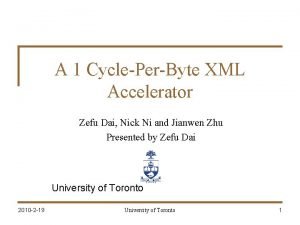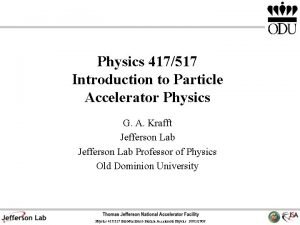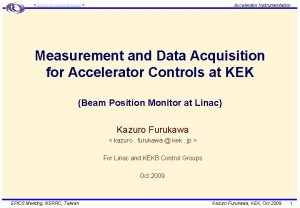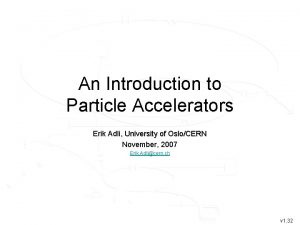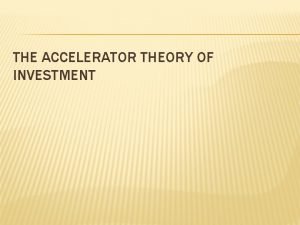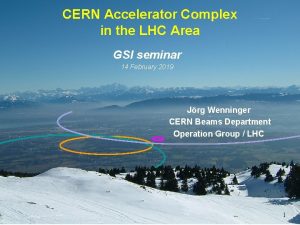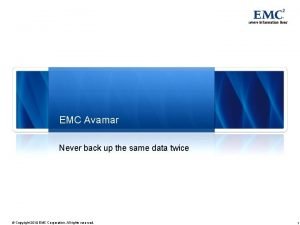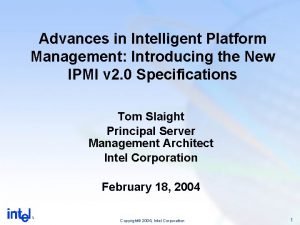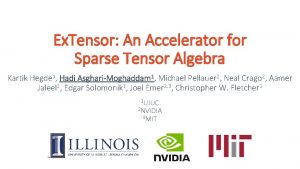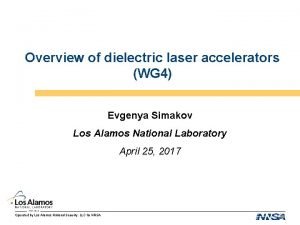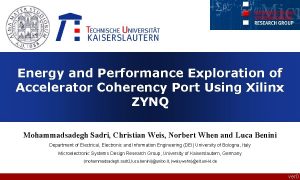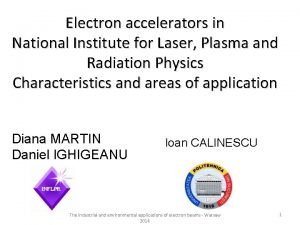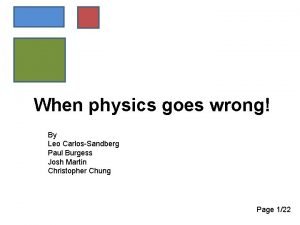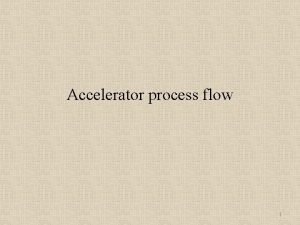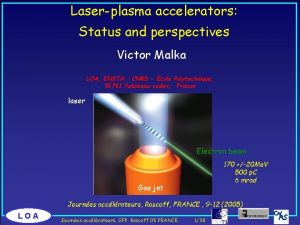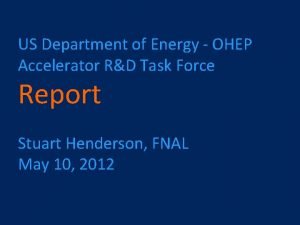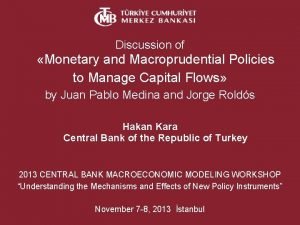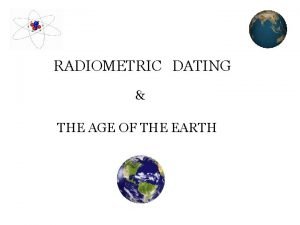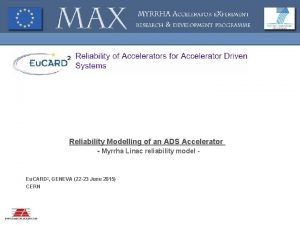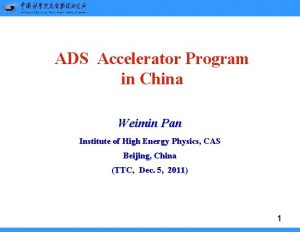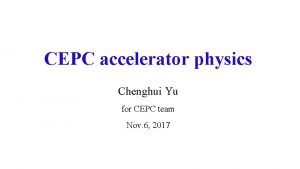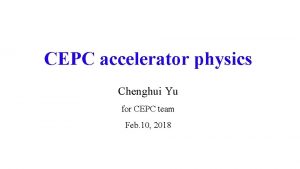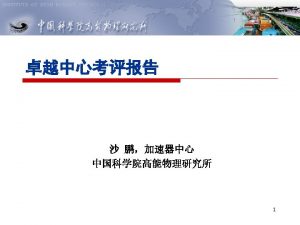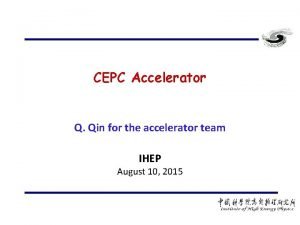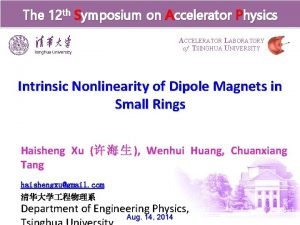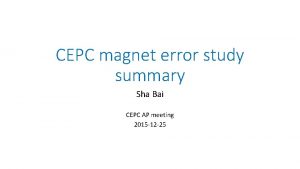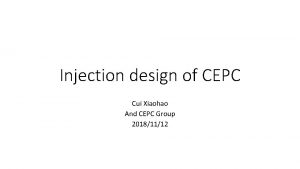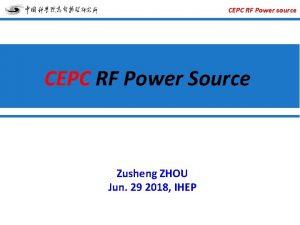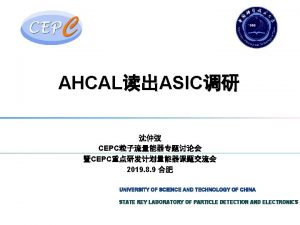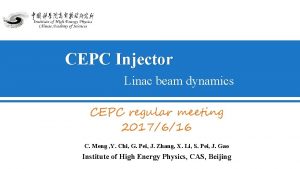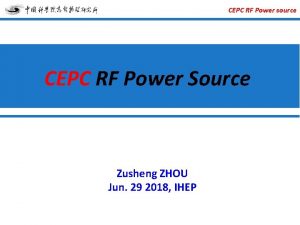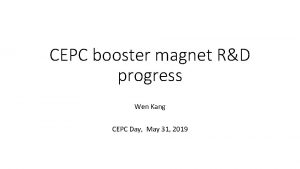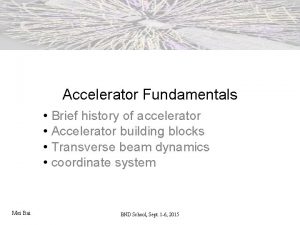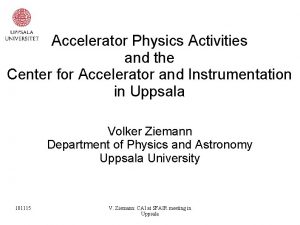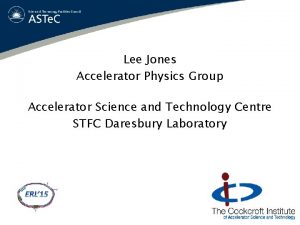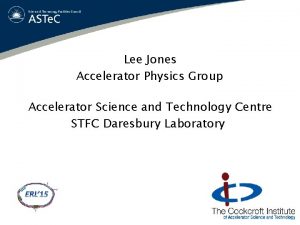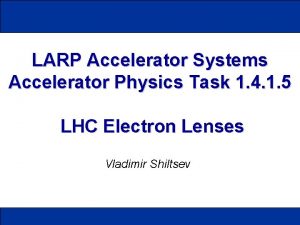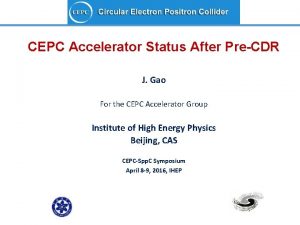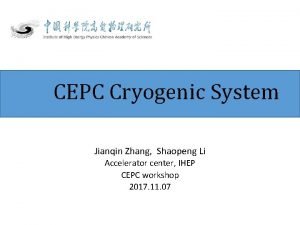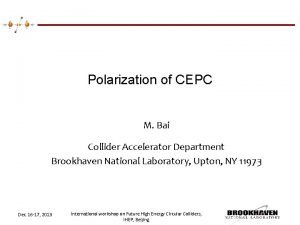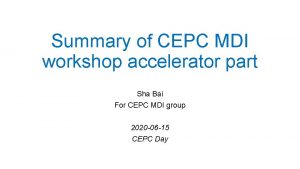The 13 th Symposium on Accelerator Physics CEPC







































- Slides: 39

The 13 th Symposium on Accelerator Physics CEPC Parameter Choice Dou Wang, Chenghui Yu, Yuan Zhang, Yiwei Wang, Huiping Geng, Sha Bai, Na Wang, Jiyuan Zhai, Xiaohao Cui, Jie Gao, Qing Qin Ji Shou, Hu Nan Province, China. 28 -30 August, 2017

Physics goals of CEPC Electron-positron collider (45. 5, 80, 120 Ge. V) – Higgs Factory • Precision study of Higgs (m. H, JPC, couplings) • Looking for hints of new physics • Luminosity > 2. 0× 1034 cm-2 s-1 – Z & W factory • Precision test of standard model • Rare decays • Luminosity > 1. 0× 1034 cm-2 s-1 – Flavor factory: b, c, t and QCD studies

Four stages towards CDR • Sawtooth effect Since Oct 2012 • Beam loading Since May 2015 • COD correction • Collision tuning Since May 2016 Since Nov 2016 3

CEPC layout 方案二 方案一

CEPC bunch distribution W&Z Higgs C 0 C=100 km 0=100 km

Beamstrahlung effect ØTypical issue for energy-frontier e+e− colliders Ø During collision, the deflected particles will lose part of its energy due to the synchrotron radiation. • • Extra energy spread Beam loss for large energy deviation life time reduction Detector background (photons, hadrons…) Divergence angle interfere the detection of small-angle events Ø Constraint for energy spread Ø Constraint for life time Large energy acceptance is essential! Harder DA!

Crab waist collision Ølarge Piwinski’s angle Øoverlapping area much smaller than σz small βy ØCrab waist sextupoles to supress betatron resonances

Machine constraints / given parameters • • • Energy E 0 Circumference C 0 NIP Beam power P 0 y* Emittance coupling factor Bending radius Piwinski angle y enhancement by crab waist Fl ~1. 5 Energy acceptance (DA) Phase advance per cell (FODO) 100 km

Constraint for CEPC parameter choice Ø Limit of Beam-beam tune shift Fl: y enhancement by crab waist Ø Beam lifetime due to beamstrahlung BS life time: 30 min Ø Beamstrahlung energy spread A= 0/ BS (A 5) Ø HOM power per cavity (coaxial coupler) 9

Parameter choice – step 1 Beam-beam limit: Fl: y enhancement by crab waist, ~ 1. 5 for Higgs, 1. 9 for W and 2. 6 for Z.

Parameter choice – step 2

Parameter choice – step 3 BS life time: 30 min y: -- phase advance/cell, -- bending angle/cell. Estimate :

Parameter choice – step 4

Parameter choice – step 5 Effective bunch length: overlap area of colliding bunches Hour glass effect:

Parameter choice – step 6 Vrf , s Energy acceptance from RF:

Parameter choice – step 7 Ø Beam lifetime due to radiative Bhabha scattering Ø Beam lifetime due to Beamstrahlung Ø HOM power per cavity HOM loss factor: *V. I. Telnov, "Issues with current designs for e+e- and gamma colliders“, Po. S Photon 2013 (2013) 070. https: //inspirehep. net/record/1298149/files/Photon%202013_070. pdf

Cross-section for radiative Bhabha scattering

Lifetime due to radiative Bhabha Ø For CEPC(Pre-CDR) and FCCee, • Life time of FCCee: 72 min • Life time of CEPC(Pre-CDR) : 55 min Ø For CEPC(CDR) • Life time of CEPC(CDR) : 100 min Ø Life time due to beamstrahlung and Bhabha at the same level for CEPC

CEPC CDR parameters Number of IPs Energy (Ge. V) Circumference (km) SR loss/turn (Ge. V) Half crossing angle (mrad) Piwinski angle Ne/bunch (1010) Bunch number Beam current (m. A) SR power /beam (MW) Bending radius (km) Momentum compaction (10 -5) IP x/y (m) Emittance x/y (nm) Transverse IP (um) x/ y/IP RF Phase (degree) VRF (GV) f RF (MHz) (harmonic) Nature z (mm) Total z (mm) HOM power/cavity (kw) Energy spread (%) Energy acceptance by RF (%) n Life time due to beamstrahlung_cal (minute) F (hour glass) Lmax/IP (1034 cm-2 s-1) Higgs W Z-low lum. Z-high lum. 2 120 100 1. 61 16. 5 2. 28 9. 68 420 19. 5 31. 4 1. 15 0. 36/0. 002 1. 18/0. 0036 20. 6/0. 085 0. 025/0. 085 128 2. 03 650 2. 75 2. 85 0. 42 (2 cell) 0. 096 1. 1 1. 98 0. 19 63 2 80 100 0. 32 16. 5 3. 6 5700 98. 6 31. 3 11. 4 1. 15 0. 36/0. 002 0. 52/0. 0017 13. 7/0. 059 0. 014/0. 068 134. 7 0. 45 650 2. 98 3. 0 0. 38 (2 cell) 0. 064 2 45. 5 100 0. 033 16. 5 6. 33 2. 3 3510 38. 8 1. 3 11. 4 1. 15 0. 36/0. 002 0. 17/0. 0038 7. 81/0. 087 0. 017/0. 053 151 0. 069 650 2. 92 3. 0 0. 096 (2 cell) 0. 036 2 45. 5 100 0. 033 16. 5 6. 33 2. 3 27000 298. 5 9. 9 11. 4 1. 15 0. 36/0. 002 0. 17/0. 0038 7. 81/0. 087 0. 017/0. 053 151 0. 069 650 (217800) 2. 92 3. 0 0. 74 (2 cell) 0. 036 1. 46 0. 11 1. 2 0. 12 0. 93 2. 0 0. 963 5. 6 0. 987 1. 0 0. 987 7. 7 19

Higgs Luminosity vs. crossing angle • Keep beamstrahlung life time constant (52 min) 100 km luminosity emittance

Higgs Luminosity vs. y* • Keep beamstrahlung life time constant (52 min) 100 km luminosity emittance

Higgs Luminosity vs. SR power 100 km goal

MDI related parameters old new L* (m) 1. 5 2. 2 Crossing angle (mrad) 30 33 Strength of QD 0 (T/m) 200 150 Strength of detector solenoid (T) 3. 5 3. 0 Strength of anti-solenoid (T) 13 7. 0

Vertical emittance induced by solenoid • Vertical emittance growth Higgs: 0. 07 pm W: 0. 2 pm Z: 1. 3 pm • Vertical emittance at Z pole is most dangerous with solenoid! Real model • Coupling: 0. 3% for Higgs and W • Larger coupling factor (2. 2%) at Z pole Detector

CEPC upgrade (wangdou 20161219 -100 km_1 mm y) tt H-high lumi. H-low pow. W Z 2 2 45. 5 100 0. 034 15 15 5. 69 0. 46 16666 65716 367. 7 1449. 7 12. 7 50 11 11 3. 3 0. 12/0. 001 0. 93/0. 0049 10. 5/0. 07 0. 0075/0. 054 160. 8 0. 11 650 (217800) 3. 93 4. 0 1. 6(1 cell) 6. 25(1 cell) 0. 037 Number of IPs Energy (Ge. V) Circumference (km) SR loss/turn (Ge. V) Half crossing angle (mrad) Piwinski angle Ne/bunch (1011) Bunch number Beam current (m. A) SR power /beam (MW) Bending radius (km) Momentum compaction (10 -5) IP x/y (m) Emittance x/y (nm) Transverse IP (um) x/ y/IP RF Phase (degree) VRF (GV) f RF (MHz) (harmonic) Nature z (mm) Total z (mm) HOM power/cavity (kw) Energy spread (%) Energy acceptance (%) 2 175 100 7. 55 15 1. 6 1. 41 98 6. 64 50 11 1. 3 0. 2/0. 002 3. 19/0. 0097 25. 3/0. 14 0. 016/0. 055 122. 2 8. 92 650 2. 62 2. 7 0. 53(5 cell) 0. 14 2 2 120 100 1. 67 15 2. 5 1. 12 555 29. 97 50 11 0. 96 0. 3/0. 001 1. 01/0. 0031 17. 4/0. 055 0. 029/0. 083 123. 3 2. 0 650 2. 72 2. 9 0. 75(2 cell) 0. 098 1. 5 2 120 100 1. 67 15 2. 5 1. 12 211 11. 4 19 11 0. 96 0. 3 /0. 001 1. 01/0. 0031 17. 4/0. 055 0. 029/0. 083 123. 3 2. 0 650 2. 72 2. 9 0. 28(2 cell) 0. 098 1. 5 2 80 100 0. 33 15 3. 57 1. 05 1000 50. 6 16. 7 11 3. 1 0. 1 /0. 001 2. 68/0. 008 16. 4/0. 09 0. 0082/0. 055 149 0. 63 650 (217800) 3. 8 3. 9 1. 0 (2 cell) 0. 065 Energy acceptance by RF (%) n Life time due to beamstrahlung_cal (minute) F (hour glass) L /IP (1034 cm-2 s-1) 2. 6 0. 23 50 1. 8 0. 26 52 1. 5 0. 26 1. 1 0. 18 0. 89 0. 62 0. 83 5. 42 0. 83 2. 06 0. 84 4. 08 0. 91 18. 0 0. 91 70. 97 25

100 km CEPC luminosity potential (1 mm y+50 MW/beam) z W H

CEPC Luminosity vs circumference * Fabiola Gianotti, Future Circular Collider. Design Study, ICFA meeting, J-PARC, 25 -2 -2016. 27

Nonlinearity sources The undisturbed linear part, The kinematic part, The influence of the fringe field, The octupole component. Amplitude dependent non-linear tune shift: So,

Kinematic effects • Hamiltonian includes the high-order terms of Px and Py. • nonlinear kinematic effect originated from the large angles of particles in the interaction region is responsible for the large tune-shift which in turn limits the dynamic aperture. Then, A. Bogomyagkov, S. Glykhov, E. Levichev, P. Piminov

Quadrupole fringe fields With a simple model of two matched parabolas for fringe field A. Bogomyagkov, S. Glykhov, E. Levichev, P. Piminov

Chromatic sextupoles Vertical chromatic sextupole pair separated by –I transformer gives the following coordinate transformation in the first order*) Pair of sextupoles Octupole By analogy to the octupole and using the expression for the FF chromaticity we found for the vertical detuning (2 pairs) *) A. Bogomyagkov, S. Glykhov, E. Levichev, P. Piminov http: //arxiv. org/abs/0909. 4872 Seminar at CERN, March 24 th 2014 31

CEPC amplitude-tune dependence x=0. 22 y=0. 002 Kinematic effects Fringe field (QD 0+QF 1) x=0. 144 y=0. 002 Kinematic effects Fringe field (QD 0+QF 1) Cxx (m-1) Cxy (m-1) Cyy (m-1) 3. 7 271 44762 2. 0+1. 4 5788+2444 21. 3+4. 0 Cxx (m-1) Cxy (m-1) Cyy (m-1) 8. 6 414 44762 3. 0+2. 0 8558+3450 21. 3+3. 7 Ø Larger x* give help to DA while keeping y*! * Nonlinear effect of sextupole pairs can be corrected by the attached weak sextupole pairs.

Luminosity vs. betax*

Energy acceptance vs. betax* • Larger x* release the difficulty of DA study.

Summary • A consistent design method for CEPC parameter choice with carb waist scheme has been created. • The 100 km Double Ring configuration with shared SCRF has been defined as baseline in order to avoid the sawtooth and beam loading effects. • CEPC was optimized at Higgs energy. W and Z just make do with what they have. • 2 mm y* and 31 MW SR power for CDR. Further upgrade was also considered. • Requirement for energy acceptance reduced to 1. 1% by enlarging the ring and x*. • Recently, x* was increased to 0. 36 m for better DA.

THANKS FOR YOUR ATTENTION!

Back up

parameters for CEPC double ring (wangdou 20170306 -100 km_2 mm y) Pre-CDR Higgs W Z Number of IPs Energy (Ge. V) Circumference (km) SR loss/turn (Ge. V) Half crossing angle (mrad) Piwinski angle Ne/bunch (1011) Bunch number Beam current (m. A) SR power /beam (MW) Bending radius (km) Momentum compaction (10 -5) IP x/y (m) Emittance x/y (nm) Transverse IP (um) x/ y/IP RF Phase (degree) VRF (GV) f RF (MHz) (harmonic) Nature z (mm) Total z (mm) HOM power/cavity (kw) Energy spread (%) Energy acceptance (%) 2 120 54 3. 1 0 0 3. 79 50 16. 6 51. 7 6. 1 3. 4 0. 8/0. 0012 6. 12/0. 018 69. 97/0. 15 0. 118/0. 083 153. 0 6. 87 650 2. 14 2. 65 3. 6 (5 cell) 0. 13 2 2 120 100 1. 67 16. 5 3. 19 0. 968 412 19. 2 32 11 1. 14 0. 171/0. 002 1. 31/0. 004 15. 0/0. 089 0. 013/0. 083 128 2. 1 650 2. 72 2. 9 0. 41(2 cell) 0. 098 1. 5 2 80 100 0. 33 16. 5 5. 69 0. 365 5534 97. 1 32 11 1. 14 0. 171 /0. 002 0. 57/0. 0017 9. 9/0. 059 0. 0055/0. 062 126. 9 0. 41 650 (217800) 3. 37 3. 4 0. 36(2 cell) 0. 065 2 45. 5 100 0. 034 16. 5 4. 29 0. 455 21300 465. 8 16. 1 11 4. 49 0. 16/0. 002 1. 48/0. 0078 15. 4/0. 125 0. 008/0. 054 165. 3 0. 14 650 (217800) 3. 97 4. 0 1. 99(2 cell) 0. 037 Energy acceptance by RF (%) n Life time due to beamstrahlung_cal (minute) F (hour glass) Lmax/IP (1034 cm-2 s-1) 6 0. 23 47 2. 1 0. 26 52 1. 1 0. 15 1. 1 0. 12 0. 68 2. 04 0. 96 2. 0 0. 98 5. 15 0. 96 11. 9 38

Z luminosity vs. coupling
 Cepc logo
Cepc logo Cepc logo
Cepc logo Atlas accelerator module
Atlas accelerator module Xml accelerator
Xml accelerator Coherent accelerator processor interface
Coherent accelerator processor interface Physics
Physics Medical particle accelerator
Medical particle accelerator Fiscal policy definition
Fiscal policy definition Accelerator
Accelerator Sap citizen engagement accelerator
Sap citizen engagement accelerator Erik adli
Erik adli Compost accelerator homebase
Compost accelerator homebase Stanford linear accelerator tours
Stanford linear accelerator tours Limitations of accelerator theory of investment
Limitations of accelerator theory of investment Cern accelerator complex
Cern accelerator complex Avamar ndmp
Avamar ndmp Cern accelerator school 2021
Cern accelerator school 2021 Ccat azure accelerator
Ccat azure accelerator Extensor: an accelerator for sparse tensor algebra
Extensor: an accelerator for sparse tensor algebra Dielectric wall accelerator
Dielectric wall accelerator Pharmaceutical cpq
Pharmaceutical cpq Accelerator coherency port
Accelerator coherency port Mvmc download
Mvmc download Dielectric laser accelerator
Dielectric laser accelerator Netbackup accelerator best practices
Netbackup accelerator best practices Anatolij bugorski
Anatolij bugorski Biztalk accelerator for swift
Biztalk accelerator for swift Growth accelerator coach
Growth accelerator coach Charter network accelerator
Charter network accelerator Backup process flow
Backup process flow Loa accelerator
Loa accelerator Sandra biedron
Sandra biedron Financial accelerator
Financial accelerator Tca accelerator drops directions
Tca accelerator drops directions United way social innovation accelerator
United way social innovation accelerator Project dtf reality kings
Project dtf reality kings Dating
Dating Ads accelerator
Ads accelerator Ads accelerator
Ads accelerator Netbackup accelerator
Netbackup accelerator
